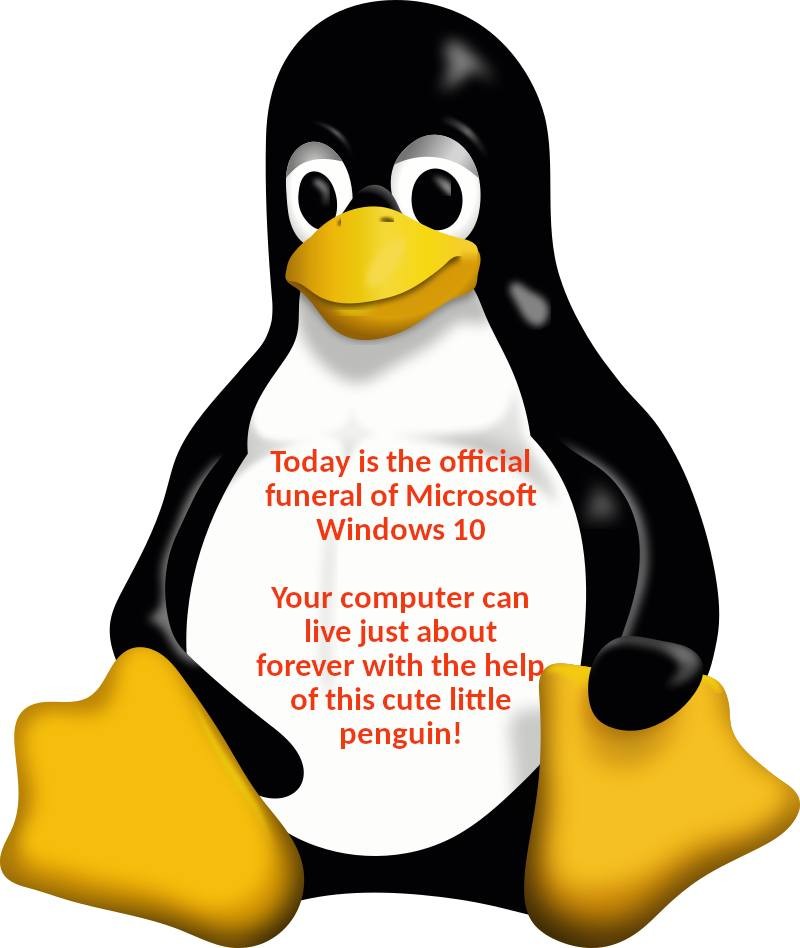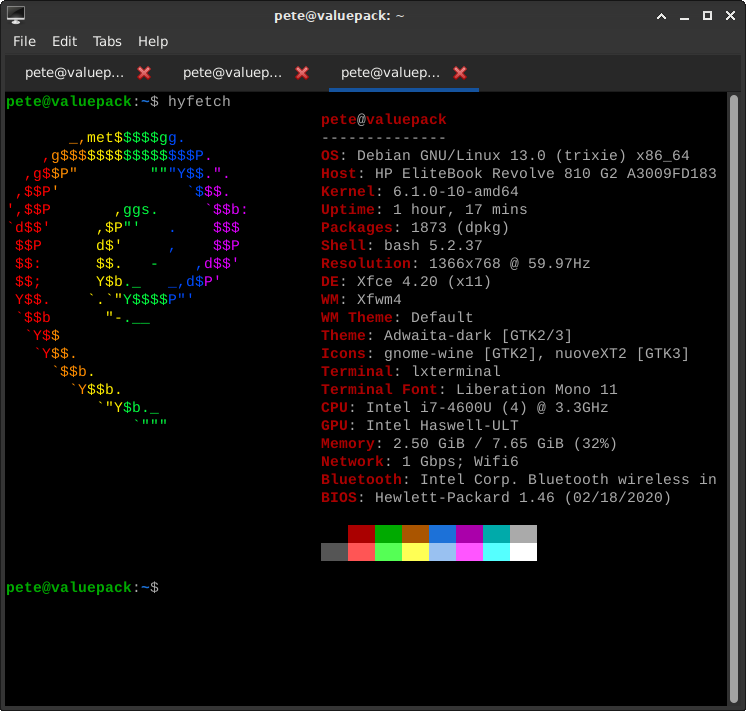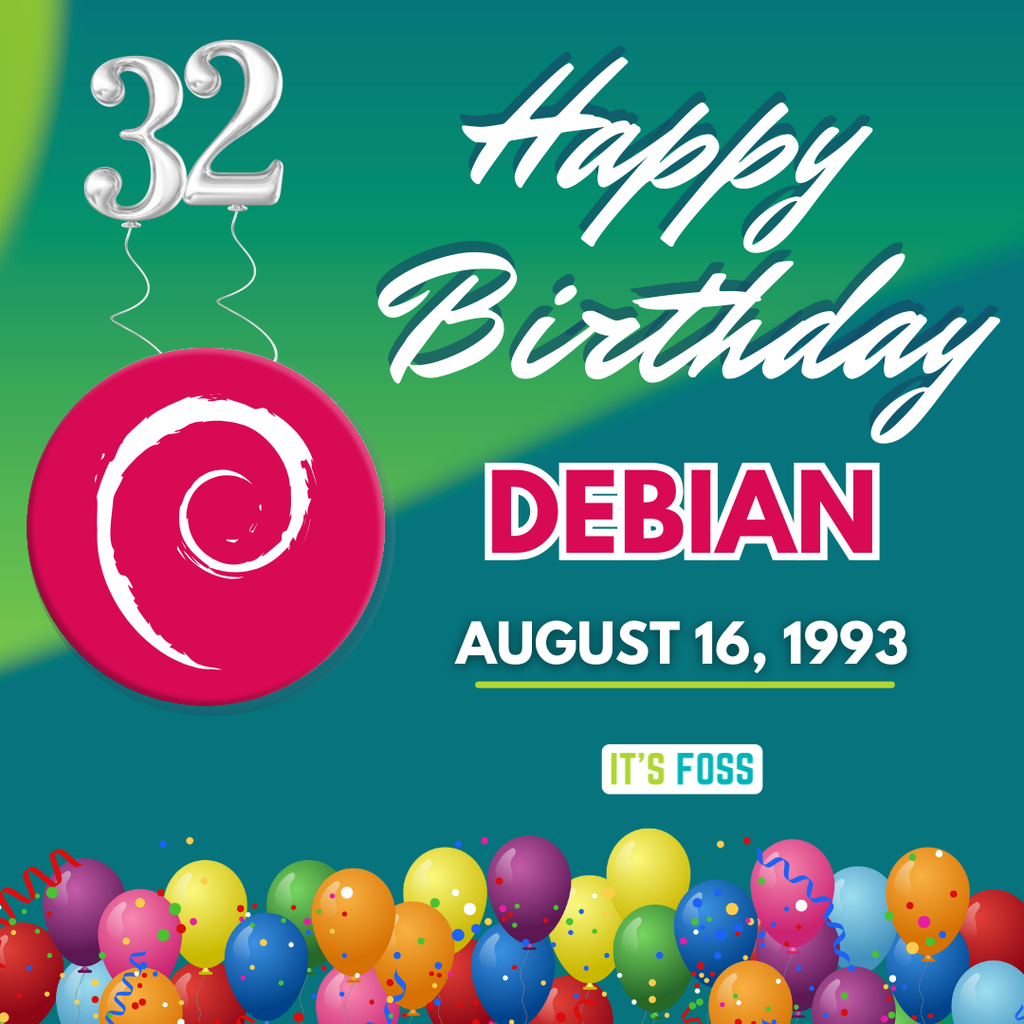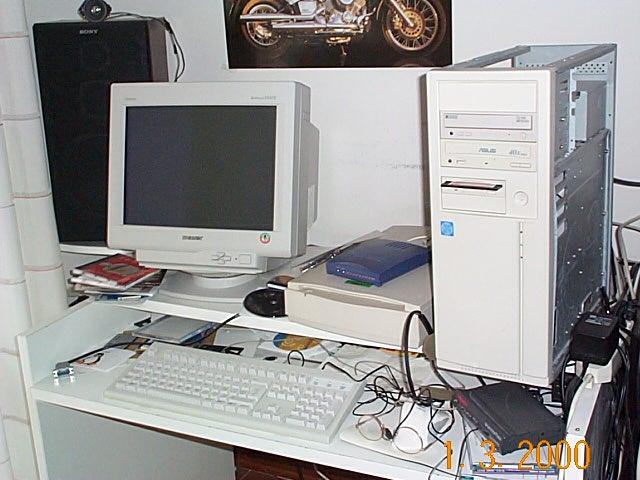Search results for tag #debian
I Have To Agree!
#Linux #Windows #Debian #LinuxMint #Ubuntu #FedoraAtomic #Fedora #ArchLinux #Arch #Meme #Memes #Humor
A while ago, my brother gave me his old Samsung NC110 netbook. I was contemplating just tossing it to recycling, but ended up installing #BoronLinux on it. Boron interface isn't half-bad for small netbook displays, but it isn't exactly light-weight as it runs the full #debian kernel. Still, it takes up only slightly over quarter of 2GB memory, so with the light-weight desktop environment, it's not too bad considering the potato CPU and low RAM. I'm thinking if I should replace the HDD with a spare SSD, maybe RAM as well if I got my hands on an upgrade for gratis, just because - not that I have any particular use for it, though. Maybe #pihole? Still, I'd probably prefer passive cooling for any Pi-hole applications.
#doomEternal auf Nightmare habe ich ja jetzt durch, auf #Control habe ich gerade noch nicht so richtig Lust Was soll ich heute Abend anfangen? Irgendwas kurzweiliges, aber belangloses wäre nett. #debian #linux #gaming
| Dann halt Scorn?: | 0 |
| Nee, lieber RoboCop!: | 1 |
| Du hast die Sniper Ghost Warrior noch nicht zu Ende gespielt.: | 0 |
Some of these linux distros absolutely need better marketing and information presentation! There are kickass features I discover in some of these that has me like, "why wasn't this obvious or prominently highlighted before this is awesome!"
Well this is going to cause a stir.
I wonder how other distros depending on Debian will feel about this change.
"It's important for the project as whole to be able to
move forward and rely on modern tools and technologies
and not be held back by trying to shoehorn modern software
on retro computing devices."
This quote from the article vexes me deeply. It feels like an accusation as an confession.
Was macht #snap denn besser als #flatpak? Ich bevorzuge ja die Pakete meiner Distribution, aber es gibt vereinzelt schon Szenarien wo man sich was externes am System vorbei installieren will. Bisher nutze ich dafür auf #Debian flatpak.
@carolina@norden.social @mthie@fedi.mthie.com
#Debian introducing hard #Rust dependencies in APT. I don’t care about Rust at all, and also don’t care about APT internals as long as it works. But Rust developers never fail to word their rewrite announcements sound arrogant and totally dick. https://lists.debian.org/debian-devel/2025/10/msg00285.html
@rqm Looking at that thread, there are definitely people who are not thrilled about the idea.
Call me a reactionary but I seriously think #debian dropping support for all old hardware because .. Rust... is very shortsighted.
https://lists.debian.org/debian-devel/2025/10/msg00285.html
Endlich! Ich habe es geschafft, die Dovecot-Konfiguration aus meiner Mailserver-Anleitung auf das neue Dovecot 2.4 aus Debian Trixie anzupassen.
Welche Parameter anzupassen sind (und eine komplette Beispielkonfiguration) findet ihr in meinem Blog:
"Alte Dovecot Konfiguration zu Dovecot 2.4 (Debian Trixie) migrieren" - https://thomas-leister.de/mailserver-migrate-config-to-dovecot-2.4-debian-trixie/
I'm running some tests on my old and trusted Raspberry Pi A+.
I've installed Raspbian - latest release, lite version. At the prompt, it's using 92 MB of RAM, mainly due to systemd and NetworkManager. As soon as you use it (even just for apt), it starts swapping and becomes almost unusable. It took 5 minutes just to install Python.
I tried NetBSD (on the same memory card): 35 MB of RAM used (including Postfix!) and it's totally usable.
What would you think about a new API endpoint that lets you run unattended upgrades with a simple call like:
/nodes/{node_name}/apt/upgrade
At the moment you need to use the node’s HTML5 console to perform upgrades. Other methods exist such as running unattended Debian upgrade scripts, using patch management tools like #Spacewalk or #QualvoSec, or automating the process with #Ansible over SSH. My idea is to have an API based solution that relies on Proxmox authentication and authorization. This would also allow third party tools such as #ProxLB to provide automated patch management and even handle guest rebalancing in a way that is similar to DRS without requiring direct SSH access.I have already been running this approach on several internal clusters since the release of PVE 8 without issues. Now I am interested to hear if you would use unattended upgrades in general or if you are already running them today.
#Linux #OpenSource #PatchManagement #Security #DevOps #Automation #Ansible #PVE #PVE8 #PVE9
Q4OS 6.1 "Andromeda" released, based on Debian 13.1 "Trixie", with KDE Plasma 6.3.6 and Trinity desktop 14.1.5
https://q4os.org/blog.html#news250912
#q4os #debian #linux #kdeplasma #trinitydesktop #linuxdesktop #debiantrixie
#pve #pve8 #pve9 #airgapped #offline #airgap #debian #repository #apt #mirror #aptmirror #opensource #virtualization
https://gyptazy.com/blog/proxmox-in-air-gapped-environment-local-repository-mirror/
https://gyptazy.com/blog/debian-13-trixie-final-lxc-container-image-for-proxmox8-proxmox-9/
I recently had to do some Docker related things which meant that it was time to retry Linux. My first idea was to install Debian SID and Void Linux - using dm-crypt and LVM on a spare laptop, and I wanted to tell the story of my time using each, as maybe you can get something out of it. Let'a get on with the story now.
# 1. Setting up Debian
I had no idea if the GUI installer for Debian was going to cause an issue, so I went for the next best thing: a KDE image and debootstrap. I was pretty confused by a lot of things, examples of which being setting rd.luks.uuid, locales, and I thought I install systemd in the initramfs as if it were Arch but I eventually gave up and used /etc/crypttab with it working. I had a Debian with full KDE setup in 2 days.
# 2. Setting up Void
I also set up Void while booted into Debian because I had prepared LVM for that when setting up Debian. I had to variate from the Void Linux disk encryption setup because using LUKS1 just felt weird. But I did borrow the crypttab setup from Debian which worked with a caveat: I had to decrypt twice. This was fixed by someone in the voidlinux libera channel thankfully. I had a nearly fully working Void with KDE setup at the end.
# 3. Issues with Void
With everything setup so that PipeWire could start with D-Bus, it did not start. I had another issue related to wireplumber and pipewire-pulse because I forgot to link their configs to `/etc/pipewire/pipewire.conf.d`. Other than that, no notable issues with Void.
# 4. Issues with Debian
I really like packaging things, and thought of adding a package I really wanted to Debian, but I really cannot wrap my head around packaging for Debian. I get it somewhat, use the `dh-*` set of tools to make a package for Meson, cargo, etc. but I'm still kind of stumped outside of that. I really like FreeBSD ports, NixOS packages and XBPS templates from Void as they are really simple to work with. I won't say that it's awful to work with Debian's packaging as I really have not had enough time to understand it.
# 5. Next stop, NixOS
I was previously a NixOS user, and I really need to revisit it as I used to really like it and haven't used it in a while. Additionally, I am also a maintainer for a few nixpkgs packages myself, so it would probably be a good idea for me to use NixOS to have the nicities of it while also contributing back to nixpkgs more. I like it for the same reasons as everyone else.
# 6. Why not FreeBSD
I love FreeBSD, and would like to put it on everything I own, but I had to use Docker. Installing Docker in FreeBSD looks really messy. I had no choice other than to set up Linux, on thankfully a spare laptop and not my main machine. I'll be honest, if I didn't need Docker, I would just use FreeBSD on that laptop.
# 7. The End
That's my chaptered semi-rant about my journey with 2 Linux Distributions, and any options I may also pick. Honestly, FreeBSD is not as complicated in my opinion due to documentation, tooling and ease of use of said tooling. Jails, bhyve and other nicities are also pretty cool. Tha ks for reading.
Debian 13 "Trixie" released with official support for riscv64, HTTP boot support, 64-bit time_t ABI, GNOME 48, KDE Plasma 6.3, Xfce 4.20, LXQt 2.1, Linux Kernel 6.12 LTS
https://www.debian.org/releases/trixie/release-notes/index.en.html
My home desktop - 1 March 2000 - a Pentium 233 MMX.
The OS was Debian Linux - you can see a printed Tux near the keyboard.
No broadband connection, just a 56k modem.
Iomega Zip drive - so I could download stuff at Uni and bring it back home.
One year later, this became my first 24/7 server.
#IT #SysAdmin #Linux #Debian #Throwback #Memories #Vintage #OldPhotos #OldTimes #OldNerd #OldMe #VintageSetup
Proxmox VE 9.0 released based on Debian 13 "Trixie", with snapshots for thick-provisioned LVM shared storage, affinity rules in HA clusters, new fabrics function for SDN, support for adding new devices to a ZFS RAID-Z Pool with minor downtime
https://www.proxmox.com/en/about/company-details/press-releases/proxmox-virtual-environment-9-0
#proxmoxve #proxmox #debian13 #debian #hypervisor #virtualization
#RUNBSD! But BoxyBSD now also starts to support #Linux! We're starting soon with the Linux support for already present users, offering free boxes:
* #AlmaLinux
* #Alpine
* #Debian
* #Devuan
* #CentOS
* #Fedora
* #Gentoo
* #OpenSuse
* #OpenEuler
* #RockyLinux
Just next to our core OS like #FreeBSD, #OpenBSD, #NetBSD, #MidnightBSD and #DragonflyBSD (and #illumos). This should also make the step easier to compare and test different scenarios where BSD provides a different behavior compared to Linux systems.
Thanks to @gyptazy for the implementation!
#VPS #VM #VirtualMachine #OpenSource #Hosting #IPv6 #BGP #FreeHosting #Community
The release of Debian 13 "Trixie" is near as the Full Freeze starts on July 27th. The final release it set for August 9th.
Debian 13 will add official support for riscv64, a total amount of 11294 new packages, over 42821 packages will be updated, and it will transition to 64-bit time_t ABI
More informations on their release notes:
https://www.debian.org/releases/trixie/release-notes/whats-new.en.html#what-s-new-in-the-distribution
I have a theory about 6-month Linux and BSD upgrades having their own kind of "stability" because there's not as far to go between releases https://zola.passthejoe.net/blog/six-month-stability/
This time it's #Debian with #Docker. I used to avoid containers, preferring to run services directly instead. But setting up backups made me appreciate the separation between the application data in image and persistent state in mounted volumes. The final piece that convinced me is the ability to self-host my own container registry with @forgejo@floss.social
I'm doing the initial setup through #Ansible (learned from @notthebee@tilde.zone), but specific applications are managed via dockge. The ambition to do every adjustment through playbooks burns out really fast when working with a single instance.

![[?]](https://snac.bsd.cafe/kaixin/s/cc35d4b8e796c869289176c383aa3da3.png)

![[?]](https://social.mdosch.de/martin/s/52bf05e4184797def7ae4fb8b34ea68e.png)





